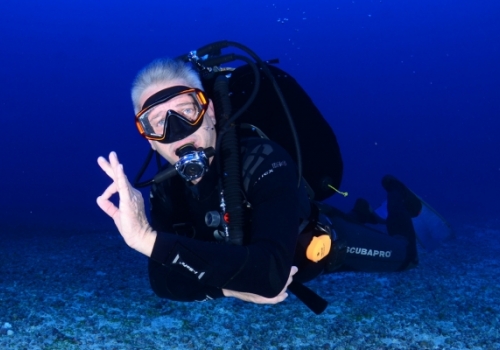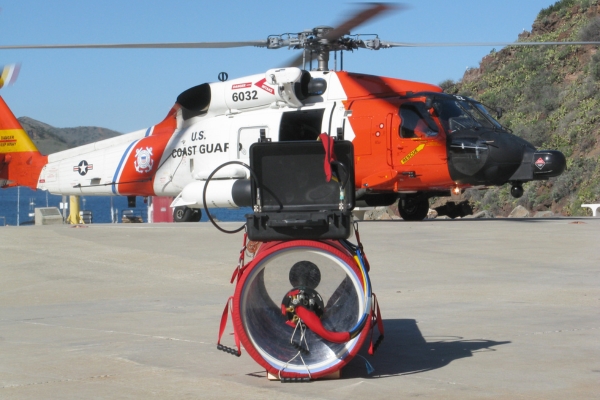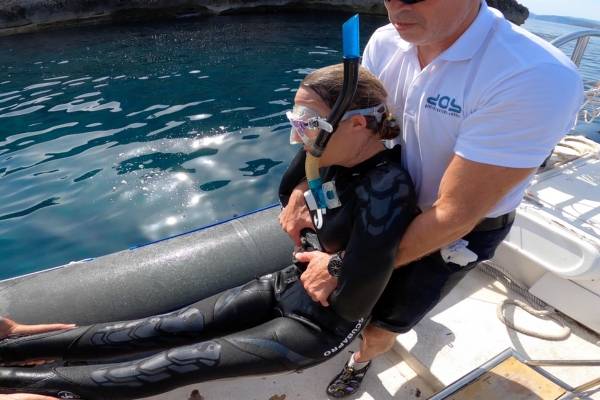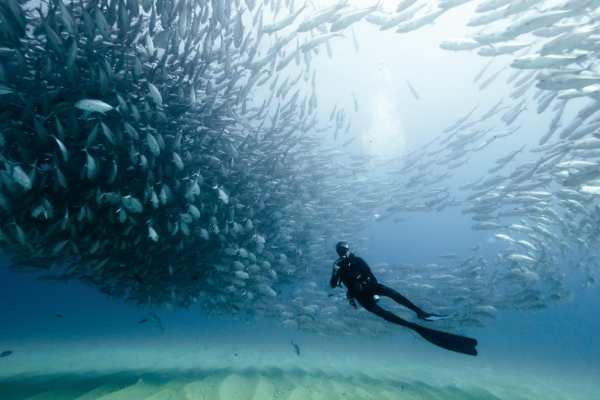
In commemoration of Don Jaime Fernández Begoña Epalza (1927-2010), I would like to share a curious anecdote about diving safety that he shared with me back in 2007.
Don Jaime was the first commercial diver in the small town of Getxo (Spanish Basque Country). While looking at his old dive helmet in a room dedicated to his collection of relics found underwater over the years, I asked him how they monitored their ascend speed and bottom time back in the day. He mentioned that they knew the US military dive tables by heart, but essentially, they would light up a cigarette as soon as they came out of the water. If the cigarette tasted ‘good’, all was fine, but if it had a ‘bad’ taste, they would return to the water and complete more decompression time and a slower ascent.
The moral of the story: When it comes to scuba safety, we don't talk about it.
Diving accidents and fatalities on board private yachts or commercial vessels are difficult to trace for obvious and understandable reasons, and “we don’t talk about it” is the preferred debriefing. As a foundation, DAN (Divers Alert Network) shares estimated numbers related to scuba diving fatalities through their network, but these only reflect a segment of the reality.
Regarding crew-related incidents and accidents during dive operations on board, the statistics are unavailable as the matter’s scope is not explicitly monitored within the maritime industry. But 'safety first' under water is more than a priority; it’s non-negotiable!
When recommending additional crew training and safety solutions after concluding an onboard assessment, we too often hear, “It never happened before” or “We’ve always done it this way”. But life has no price, till it has, and it never happens, till it does.
Generally, when we ask the crew to show us how to recover a 100kg (220lb) unconscious diver back on board the tender, we can usually continue the conversation towards a common goal to work on.
Mitigate the risk
Crew training and good quality equipment have a price, which is part of the overall cost of scuba activities. Emergency preparedness goes hand in hand with training; the potential risks are mitigated through safety protocols and adequate equipment. There is no way around it, whether it is for military divers, commercial diving activities, or diving from the stern of a sailboat in the Bahamas.
The military developed their safety protocols according to the mission, commercial divers are legally bound to strict safety protocols, and in the recreational realm, the DCAs* (like PADI, SSI, CMAS, and others) do their best to teach safe diving practices within their training.

When diving from on board a ship, the complexity increases drastically, and the crew must deal with emergencies when they occur. If one dives from a private or commercial yacht, a diving liveaboard, a research vessel, or an expedition cruise vessel, the baseline is the same! One needs training and adequate equipment to run an ‘as safe as possible’ dive operation from on board.
So why does it get more complicated from on board a ship?
The lack of immediate shore support is obvious, but more specific challenges have been identified:
• The liabilities and legal obligations of the parties involved (captain, crew, guests, or dive staff) are not always clear, and the individual responsibilities must be addressed and differentiated.
• The STCW training scheme provides knowledge and certification to work on board, and the training of DCAs enables them to dive professionally, but there is no overlapping training that prepares both professional groups to work towards operational tasks and emergencies as a team.
• SOPs and emergency procedures specific to the vessel are necessary to minimise risks, but dive-related content and drills are not established within the ship ISM.
• Unlikely, as applicable when maritime crew embark, freelance dive guides are seldom given the ship’s familiarisation when boarding and a communication gap between the ship’s crew and dive personnel is real.
• Maritime crews are rarely trained in protocols specific to scuba diving, even though several departments on board are involved during dive operations.
Onboard Dive Operation Safety Management System
Dive Operations Buddy (dob) is a team of passionate divers and maritime professionals that decided to gather their experience and offer a solution to reshape the safety standards on board. Thereby, a dive operation manual and training were specifically designed to join the dots.
The ODO-SMS© is comparable to a mini ISM dedicated to scuba and snorkel operations. The purpose of the ODO-SMS© is to offer a support tool to captains and operators that establishes the necessary parameters for safety and training. The scope of the ODO-SMS© includes operational procedures, legal necessities, crew drills, equipment maintenance aids, emergency protocols, and first-aid recommendations specific to diving.
In addition to onboard training, any crew or staff member can read through the manual and related forms at any time and better understand the tasks and responsibilities related to diving activities. As much as the safety parameters to be considered on board a private yacht are the same as aboard any other vessel, such safety management systems are especially recommended for commercial vessels that offer scuba diving as an activity for guests. The manual was written by a captain/operations manager and a dive instructor/graduated master in oceanography. This document and supporting checklists were revised and amended with the expertise of an ex-chief of rescue services, the DPA at a compliance company, and the head instructor of a commercial dive academy. To complement the integrity of the content, three dive-related ISO standards were successfully integrated within the ODO-SMS© and thus provide a valuable tool for any vessel to work comfortably towards certification of the vessel.
The manual was written by a captain/operations manager and a dive instructor/graduated master in oceanography. This document and supporting checklists were revised and amended with the expertise of an ex-chief of rescue services, the DPA at a compliance company, and the head instructor of a commercial dive academy. To complement the integrity of the content, three dive-related ISO standards were successfully integrated within the ODO-SMS© and thus provide a valuable tool for any vessel to work comfortably towards certification of the vessel.
The ODO-SMS© and its training course provide guidelines and recommendations only. It is not a compliance requirement for any official regulation of the vessel or its crew, but it does provide a structure to gain and prove proficiency.
Technological advances in diving
Technologies typically mutate from the military to the commercial sector, eventually translating to a simpler and more fashionable version for recreational use. One of the most significant technological advances has been the development of a wrist-worn dive computer to monitor bottom time and ascent speed.
Another important safety feature was the development of PLBs specifically designed for divers. When lost at sea, the diver can transmit the exact position by activating a personal beacon that allows fast and efficient recovery. Several systems exist that work through AIS, VHF (DSC), or even in a closed-loop communication. Thanks to technological advances, any recreational diver can get hold of a UW-communication mask to talk to topside or another diver. Even underwater navigation systems, allowing divers and topside to simultaneously monitor relative positioning, depth and text each other, are available on the market.
Contemporary solutions for humans to explore deeper depths are possible through the mixture of gases, atmospheric dive suits, or manned submersibles. The last two solutions maintain the human body at 1 ATM, but when it comes to going deeper and exposing it to ambient pressure, one needs to be cautious of the ascent speed and decompression stops. The risks increase substantially with depth, but even a free diver or a snorkeler is not exempt from potential risks. Deep or shallow, diving will always remain an activity to be practiced with specific knowledge and preparation.
The human body in deeper depths
When diving, nitrogen is absorbed by the body (Boyle’s Law), and body tissues are saturated with the gas. When a diver ascends too quickly, the nitrogen gas in the tissues will come out of solution and expand at such a rate that the body cannot eliminate it efficiently, and the nitrogen will form small bubbles inside the tissues. This is known as decompression illness (DCI), commonly called ‘The Bends’, which can be very painful and lead to tissue death, or even be life-threatening.
 DCI encompasses decompression sickness (DCS) and arterial gas embolism (AGE). With AGE, small lung ruptures can be caused leading these tiny bubbles to enter the arterial circulation, travel through the body, and eventually lodge in blood vessels and block blood flow. The risk of permanent physical or neurological deficits could affect the diver’s future livelihood and their quality of life.
DCI encompasses decompression sickness (DCS) and arterial gas embolism (AGE). With AGE, small lung ruptures can be caused leading these tiny bubbles to enter the arterial circulation, travel through the body, and eventually lodge in blood vessels and block blood flow. The risk of permanent physical or neurological deficits could affect the diver’s future livelihood and their quality of life.
When this occurs, the technological approach to reverse the phenomenon iinvolves using hyperbaric chambers. In fact, we should call them re-compression chambers, as Hyperbaric Oxygen Therapy (HBOT) is based on bringing the diver back to depth by creating pressure in a chamber and simultaneously providing medical oxygen to the patient.
By following a treatment table, the chamber allows us to gradually decrease this pressure and bring the body back to normal surface pressure in a controlled manner. Today’s technologies offer the possibility to provide such treatments through foldable or modular chambers instead of the more common, bulky steel containerised chambers. It allows us to treat one or more patients through the same principles and simultaneously, at a lower cost, requiring less space.
One particular design is so compact that it serves as a one-person-hyperbaric-stretcher which, when folded, fits in two large pelican cases. It is the only way to evacuate a patient under treatment to the nearest hospital or hyperbaric facility. The medi-vac includes heli-vac capabilities.
Inspite of the above, we do it because we love it!
The rates charged for snorkelling and scuba diving correlate with the probabilities of seeing rare species and the luxury of the provided services. Today, the scuba diving industry is still booming wherever there is water to dive into, and it is available to most of us. So, if you’re not already a certified diver, perhaps you should look into it! It is easy to get certified, and modern technological aids make it a relatively safe practice.
The oceans that surround us are exciting and still magnificent to explore, enjoy and learn from. So, do your homework, stay safe and explore!
Captain Dominique Geysen
Founder of Dive Operations Buddy

LIST OF ACRONYMS
DCA = Dive Certification Agencies (PADI, CMAS, SSI, NAUI, SAA, SDI, and others).
STCW = Standards of Training and Certification of Watchkeeping, as determined by the International Maritime Organization (IMO). It is the international standard for training seafarers of nearly every leading flag state in the world.
SOP = Standard Operating Procedures; or procedures that describe how to confront a risk and reduce its effect.
ISM = International Safety Management code (IMO), which purpose is to provide international standards for the safe management and operations of ships and prevention of pollution.
ODO-SMS© = Onboard Dive Operation Safety Management System.
DPA = Designated Person Ashore – According to the ISM Code the Designated Person Ashore (DPA) plays a key role in the effective implementation of a Safety Management System and takes responsibility for verification and monitoring of all safety and pollution prevention activities.
ISO = International Organization for Standardization. The ISO is an independent, non-government organization, that brings global experts together to agree on the best ways to make lives easier, safer, and better through the creation of international standards.
PLB = Personal Locator Beacon(*) Topside = Surface support in charge of monitoring submerged parties.
ATM = The standard ‘atmosphere’ (abbreviated to atm) is a convenient unit for measuring pressures. 1 atm corresponds to atmospheric pressure at mean sea level.
Medi-Vac = emergency medical evacuation / ambulance, also called medevac and refers to the service that provides medical care to injured patients while being transported from an accident scene to a hospital.
Heli-Vac: Emergency medical evacuation by air, specifically from a ship, is done by helicopter.

Post your comment
You cannot post comments until you have logged in.
Login to post a commentComments
No one has commented on this page yet.
RSS feed for comments on this page | RSS feed for all comments